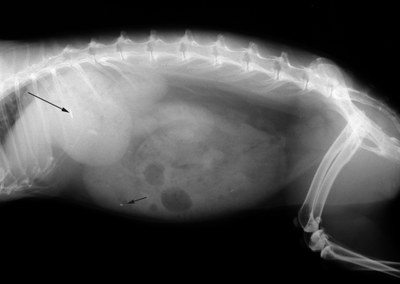A case of heavy metal poisoning
An adult rabbit was brought in to our clinic because she was depressed, not eating or defaecating and had not responded to the treatment for gut stasis. A lateral abdominal radiograph showed some suspicious radiopaque areas in the stomach and colon that could have been due to ingestion of a metallic compound but the owner was adamant that the rabbit had no access to anything toxic. The rabbit and her companion were houserabbits. The property was old but was not under renovation. 
Even though there was no history of exposure, the rabbit was admitted and treated for lead poisoning. An antidote was given (sodium calcium edetate) alongside syringe feeding, medication to stimulate gut motility and analgesia. The following morning, the owner phoned and said that she might have found the source of the problem. Both rabbits were always left in an outhouse when she was at work and she found they had been chewing at the whitewashed walls. The rabbit responded to treatment and was sent home a few days later. Her owner decided to keep the rabbits in the house all the time.

Ten days later, the rabbit was brought back to the surgery because she was unwell again. A blood sample and more radiographs were taken.This time, there was a lot of radiopaque material in the gastrointestinal tract, which puzzled the owner because the rabbit had not been back to the outhouse. The same treatment was given but the rabbit didn't respond as quickly. A blood sample was taken that showed a mild regenerative anaemia with no haematological abnormalities to suggest lead intoxication. Another antidote (penicillinamine) was started alongside supportive treatment and medication to stimulate gut motility. Luckily, the treatment was effective and some flakes of white material were passed in the faeces.


Meanwhile, the owner had searched the house and found an area of skirting board and plaster that the rabbit had been chewing. The source of the problem was identified.
This case raises some of the problems associated with toxicity in rabbits. In this case, the diagnosis of toxicosis was based on the clinical signs of gut stasis that unresponsive to treatment and the presence of radiopaque material in the gastrointestinal tract. Although many other clinical signs can be associated with lead poisoning, cessation of gut motility seems to be the most common sign in rabbits. Other species (e.g. dogs or cattle) might present with anorexia, vomiting, diarrhoea, abdominal pain or constipation before developing neurological signs such as blindness and seizures. They may show suggestive changes in the blood cells.
In this case, the toxic compound was assumed to be lead. Until the early 1960s lead was the main white pigment in paint products used for skirting boards, doors, door and window frames.Older houses still may have significant amounts of lead in original paint layers. Lead paint was also applied to plaster walls and the rabbit was stripping this off. However, further tests would have been necessary to confirm the diagnosis.The amount of lead in the blood can be analysed but the results can be difficult to interpret. A high level is diagnostic. A low level is inconclusive. Other metals can be poisonous so in many instances the diagnosis is described as 'heavy-metal poisoning'. In a similar case, which proved fatal, the source of the metallic flakes in the digestive tract came from the plastic coated wire cage that the rabbit was left in while the owner was at work. Neither the material that was in the rabbit's digestive tract nor the carrier was analysed but, eventually, enquiries about the content of the material that was used to make the plastic coating showed that it contained a small quantity of arsenic.


Red lead used to be used as an anti-corrosive primer coating for exterior steelwork. In another case of lead poisoning, the source was not clear until the owners remembered the old sunlounger that the rabbit liked to jump on. They even had a photo of him on it. Closer examination showed that he had chewed through the paintwork to expose the lead primer beneath. Treatment was successful and the sunlounger was thrown away
